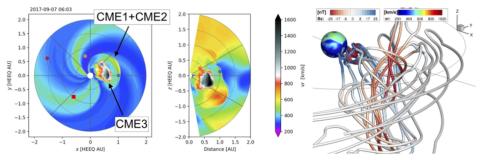The UNH/CME group has been working on numerical simulations of CMEs for more than a decade. Models typically solve magneto-hydrodynamic (MHD) equations numerically, while the MHD equations are the fundamental physical descriptions for plasma in space physics. Recently, the UNH/CME group used 2.5D MHD simulations to investigate the CME initiation, i.e., the catastrophe model, and the CME deformation in the interplanetary space. The group also uses EUHFORIA (EUropean Heliospheric FORecasting Information Asset), a 3D MHD model of the inner heliosphere designed to model the solar wind and CME propagation up to 2 AU. EUHFORIA integrated with a spheromak flux rope magnetic field configuration allows to model the internal magnetic structure of CMEs and investigate their evolution as a consequence of the interaction with other interplanetary transients, such as High Speed Streams (HSSs), SIRs, the Heliospheric Current Sheet (HCS), and other CMEs (Figure 3).

Figure 4. EUHFORIA modeling of the three interacting CMEs launched from the Sun on 4-6 September 2017, obtained using the spheromak flux rope model. Left: radial speed in the equatorial and meridional planes. Right: magnetic field lines coloured by the Bz polarity, with negative (red) regions being the most effective drivers of space weather disturbances. From Scolini et al. (2020).